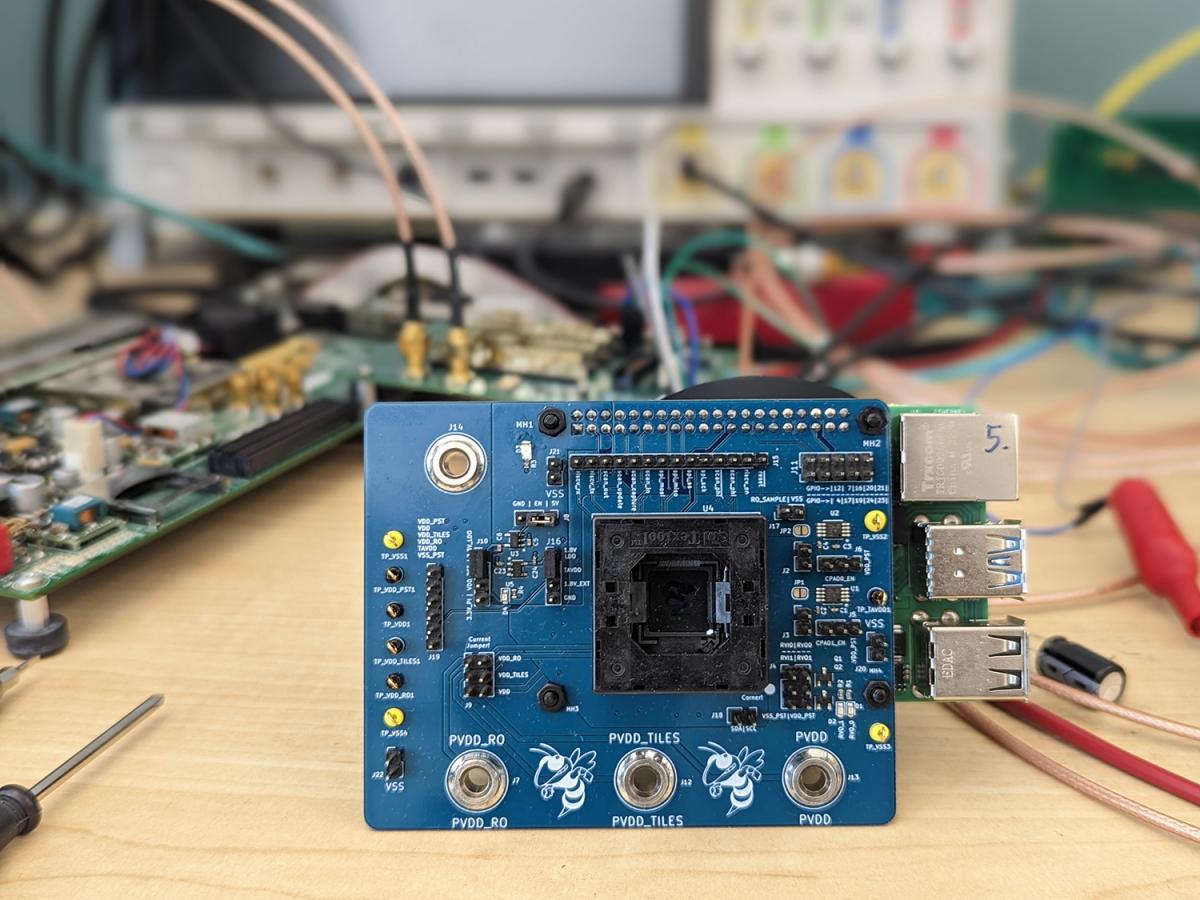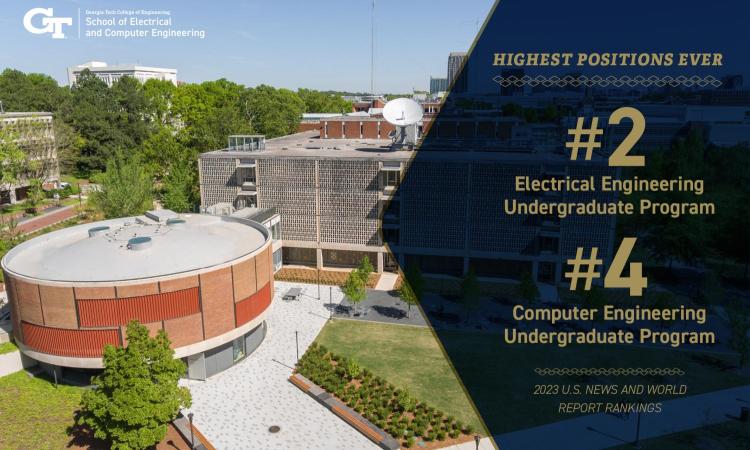(text and background only visible when logged in)

The inaugural cohort of ECE 4804 VLSI Design: Theory to Tapeout. Fernando Mujica, Visvesh Sathe, and Arijit Raychowdhury pictured to the far right (from bottom to top respectively).
In the fast-paced world of VLSI (Very Large-Scale Integrated) design, where innovation and technological advancements are constant, the demand for engineers equipped with a comprehensive understanding of the entire chip manufacturing process is soaring. Recognizing this need, the Georgia Tech School of Electrical and Computer Engineering (ECE) and Apple have collaborated to launch an innovative undergraduate course: ECE 4804 VLSI Design: Theory to Tapeout.
The academia-industry course is one of very few in the country that offers undergraduate students an opportunity to delve into the intricacies of the complete VLSI design cycle — from system specification and architectural design to fabrication and testing.
Designed and taught by Professor Visvesh Sathe, the course goes beyond mere industry training and directly addresses the escalating demand for expertise in real-world hardware design. Students experience the thrills, challenges, and satisfaction of prototyping a digital SoC (system on a chip) within the confines of a classroom.
“There is an emerging and obvious need for VLSI professionals to better understand how the sausage is made, so to speak,” said Sathe. “By comprehending the complete picture, regardless of their specific role, students will be better equipped to excel and make meaningful contributions in various roles within the hardware industry.”
Collaboration with Apple
Sathe, alongside ECE School Chair Arijit Raychowdhury, sought a partnership to bridge the academia-industry divide. They approached Fernando Mujica of Apple to help develop a VLSI course that aligned with industry interest.
The timing coincided with Apple’s New Silicon Initiative (NSI), a program designed to inspire and prepare students for careers in hardware engineering, computer architecture, and silicon chip design. The shared vision of experts from ECE and Apple materialized in the launch of the course for the Fall 2022 semester, supported by Apple’s NSI.
(text and background only visible when logged in)
"Unlike typical projects where minor setbacks can be overlooked, that approach didn't apply in this course. We were determined not to waste anyone's time. There was a heightened emphasis to get it right." - Ethan Weinstock, a student in ECE 4804
Integral to bringing the course to life were Jared Zerbe, Apple's NSI director, and Michael Liu, a senior SoC engineer at Apple, who led the group of Apple engineers involved in guest lectures and design reviews.
Emphasis on Undergraduate Students
“When I first envisioned the class, I was thinking it would be for first-year master students, but thankfully Arijit and the Apple team saw the potential to stretch its boundaries and adapt it for undergraduates,” said Sathe.
Mujica, a 1999 ECE Ph.D. graduate who is a director of engineering at Apple, added: “Considering the fundamental need for students to pursue silicon development careers, it was crucial we ensure students of all levels understand the overall flow of the industry.”
Typical undergraduate VLSI courses focus on the principles, methodologies, optimizations, and specific aspects of integrating transistors and electronic components onto integrated circuits (or chips).
Creating a comprehensive VLSI design course like ECE 4804 demands a considerable financial investment, as well as the determination to overcome the challenges of implementation and logistical complexities, according to Raychowdhury.
"The success of this course is a testament to the synergy between the Institute and the support from Apple," he said. "Offering a course of this caliber is expensive and time-consuming, but thanks to Fernando and Apple, we have paved the way for an exceptional educational experience that can serve as a template for others."

ECE Professor Visvesh Sathe teaching the inaugural cohort of VLSI Design: Theory to Tapeout during the Spring 2023 semester.

The final chip created by the student groups in ECE 4804 embedded in a printed circuit board (PCB).
Embracing Real-World Challenges Through Experiential Learning
The two-semester course of 20 students began with a broad introduction to VLSI design principles, semiconductor physics, and digital system design, establishing a strong theoretical foundation.
Students then dove into hands-on design projects that replicated real-world scenarios. The projects fostered collaboration and individual work in the design and implementation of VLSI chips to be fabricated in Taiwan Semiconductor Manufacturing Company (TSMC)'s 65nm complementary metal–oxide–semiconductor (CMOS) process.
The first semester culminated in a comprehensive understanding of the tapeout and manufacturing processes, where students gained insights into the intricacies of preparing their final design files for transfer to a semiconductor fabrication facility.

A die photograph of the test-chip implemented in the inaugural VLSI-Theory to Tapeout class.
The Importance of Testing
In the second semester of the course, as the silicon chips returned from fabrication, a new phase of learning began: test and measurement.
Raychowdhury and Sathe emphasized the critical role of testing in the course, highlighting the comprehensive approach taken.
"Test and measurement have to play a pivotal role, it can’t just be about designing and fabricating the chip,” Sathe said. “This holistic approach ensures a complete learning experience with a deeper understanding of the relationship between design and functionality for our students."
With a focus on quality assurance, students actively wrote test patterns to perform functional validation of their chips, enabling them to characterize the performance of their designs firsthand.
(text and background only visible when logged in)
Video of Ethan Weinstock displaying the printed circuit board and chip that students in ECE 4804 VLSI Design: Theory to Tapeout prototyped in the two-semester course supported by Apple.
A distinctive aspect of the course was the utilization of industry-standard Electronic Design Automation (EDA) tools, providing students with a practical experience in chip simulation and verification. By using these tools, rather than open-source or academic alternatives, students refined their debugging, testing, and design correctness skills.
Just the Beginning
“The level of collaboration and camaraderie displayed by the students, teams, teaching assistants, and instructors surpassed our expectations,” said Mujica. “The course equipped students with substantial knowledge, but also fostered essential teamwork skills, closely resembling the dynamic and problem-solving nature of real-world industry settings.”
Not only did the course succeed in replicating the industry environment, but the quality of the students’ chip designs, and their success rates, surprised nearly everyone involved.
“Given this was the first offering of the course, our hope was that at least some of the designs developed by the students would be functional. Incredibly, every single design was validated to be fully functional,” said Sathe.
Building on its impressive results, ECE hopes to grow and expand ECE 4804 to serve more students and meet the evolving demands of the VLSI industry.
Additionally, the School aims to replicate the course's success by exploring a Curriculum Partnership Initiative driven by Georgia Tech's strategic priority to develop student programs for evolving markets and to meet workforce demands. The initiative would collaborate with additional industry partners to establish similar courses in the broader realm of chip development, including analog and packaging.
Raychowdhury is confident that such unique academic experiences will attract and retain top and diverse students in circuit design.
“In turn, these students will fuel the next 50 years of growth and prosperity in a dynamic industry,” he said.
Related Articles

ECE Programs Move Up in Undergraduate Rankings
ECE undergraduate academic programs rise to their highest-ever positions in the 2023 U.S. News & World Report Best Colleges rankings.

Georgia Tech Addressing the Nation’s Call for Semiconductors
Georgia Tech's multidisciplinary semiconductor researchers working to innovate chip technology to ensure U.S. competitiveness.